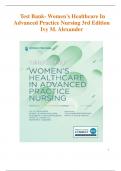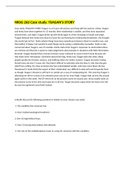Test Bank- Women’s Healthcare In
Advanced Practice Nursing 3rd Edition
Ivy M. Alexander
1
,Women's Health Care In Advanced Practice Nursing, 3rd Edition
PART I: WOMEN’S LIVES, WOMEN’S HEALTH
Chapter 1. Women And Their Health Versie Johnson-Mallard And Nancy Fugate Woods
Chapter 2. Women As Health Care Providers Diana Taylor
Chapter 3. Women And Health Care Nancy Fugate Woods, Ellen F. Olshansky, And
Deborah Ward
Chapter 4. Health Care For Vulnerable Populations Cheryl L. Cooke And Selina A.
Mohammed
Chapter 5. Legal Issues In Women’s Health Care Anna G. Small
Chapter 6. Feminist Frameworks For Advanced Practice With Women Cheryl L. Cooke And
Selina A. Mohammed
PART II: HEALTH PROMOTION AND PREVENTION FOR WOMEN
Chapter 7. Women’s Bodies, Women’s Health Nancy Fugate Woods, Ivy M. Alexander,
Annette Jakubisin-Konicki, And Lucinda Canty
Chapter 8. Young Women’s Health Catherine Takacs Witkop
Chapter 9. Midlife Women’s Health Nancy Fugate Woods, Judith Berg, And Ellen Sullivan
Mitchell
Chapter 10. Older Women’s Health Barbara B. Cochrane And Heather M. Young
Chapter 11. Well Woman’s Health Versie Johnson-Mallard And Elizabeth A. Kostas-
Polston
Chapter 12. Mental Health Gail M. Houck
Chapter 13. Nutrition For Women Heather Hutchins-Wiese
Chapter 14. Healthy Practices: Physical Activity Jiwon Choi
Chapter 15. Healthy Practices: Sleep Carol A. Landis
Chapter 16. Genetics And Women’s Health Diane C. Seibert And Elizabeth A. Kostas-
Polston
Chapter 17. Women And The Workplace Janice Camp
Chapter 18. Health Considerations For Women Caregivers Judith Berg And Nancy Fugate
Woods
Chapter 19. Women’s Sexual Health Elizabeth Kusturiss And Susan Kellogg Spadt
Chapter 20. Primary Care Of Lesbian, Gay, Bisexual, And Transgender Individuals Caroline
Dorsen And Kathryn Tierney
Chapter 21. Fertility Self-Management And Shared Management Richard M. Prior And
Heather C. Katz
Chapter 22. Preconception Counseling Debbie Postlethwaite, Elizabeth A. Kostas-Polston,
And Kristi Rae Norcross
Chapter 23. Prenatal Care And Anticipating Birth Lisa L. Ferguson
PART III: MANAGING SYMPTOMS AND WOMEN’S HEALTH CONSIDERATIONS
Chapter 24. Breast Health Considerations Deborah G. Feigel And Kathleen Kelleher
Chapter 25. Caring For The Transgender Patient Kathryn Tierney And Caroline Dorsen
Chapter 26. Sexual Health Problems And Dysfunctions Candi Bachour And Candace
Brown
Chapter 27. Vulvar And Vaginal Health Robert Gildersleeve
Chapter 28. Perimenstrual And Pelvic Symptoms And Syndromes Candy Wilson, Regina A.
Mcclure, And Elizabeth A. Kostas-Polston
2
,Chapter 29. Urologic And Pelvic Floor Health Problems Richard S. Bercik And Cherrilyn F.
Richmond
Chapter 30. Sexually Transmitted Diseases Catherine Ingram Fogel
Chapter 31. Women And HIV/AIDS Catherine Ingram Fogel
Chapter 32. Human Papillomavirus Elizabeth A. Kostas-Polston, Versie Johnson-Mallard,
And Naomi Jay
Chapter 33. Gynecologic Cancers Barbara J. Silko And Leslie J. Heron
Chapter 34. Menopause Ivy M. Alexander, Annette Jakubisin Konicki, Seja Jackson,
Devangi Ladani, Jenna Logiudice, And Lauren Vo
Chapter 35. Osteoporosis Ivy M. Alexander, Danielle Larosa, Emily Miesse, And Matthew
Witkovic
Chapter 36. The Challenge Of Unintended Pregnancies Katherine Simmonds And Lisa
Stern
Chapter 37. Infertility Rachel Oldani Bender And Elizabeth A. Kostas-Polston
Chapter 38. High-Risk Childbearing Marianne T. Stone-Godena
Chapter 39. Intrapartum And Postpartum Care Heather Dawn Reynolds, Allison Mccarson,
Lilyan Kay, Meredith Goff
Chapter 40. Mental Health Challenges Deborah Antai-Otong
Chapter 41. Substance Abuse And Women Susan Caverly
Chapter 42. Gender-Based Violence And Women’s Health Angela Frederick Amar
Chapter 43. Cardiovascular Disease In Women Tina M. Chasse Mulinski, Karin V. Nyström,
And Catherine G. Winkler
Chapter 44. Endocrine-Related Problems Adrienne Berarducci
Chapter 45. Chronic Illness And Women Tara F. Bertulfo And Theresa G. Rashdan
Chapter 46. Care Of Women With Disabilities
3
, Chapter 1 Women And Their Health
The United States Ranks 50th In The World For Maternal Mortality And 41st Among Industrialized Nations For
1. Infant Mortality Rate. When Developing Programs To Assist In Decreasing These Rates, Which
Factor Would Most Likely Need To Be Addressed As Having The Greatest Impact?
A) Resolving All Language And Cultural Differences
B) Assuring Early And Adequate Prenatal Care
C) Providing More Extensive Womens
Shelters D)Encouraging All Women To Eat A
Balanced Diet
2. When Integrating The Principles Of Family-Centered Care, The Nurse Would Include Which
Of The Following? A)Childbirth Is Viewed As A Procedural Event
B) Families Are Unable To Make Informed Choices
C) Childbirth Results In Changes In Relationships
D) Families Require Little Information To Make Appropriate Decisions
When Preparing A Teaching Plan For A Group Of First-Time Pregnant Women, The Nurse Expects To
Review
3. How Maternity Care Has Changed Over The Years. Which Of The Following Would The Nurse
Include When Discussing Events Of The 20th Century?
A) Epidemics Of Puerperal Fever
B) Performance Of The First Cesarean Birth
C) Development Of The X-Ray To Assess Pelvic Size
D) Creation Of Free-Standing Birth Centers
4. After Teaching A Group Of Students About Pregnancy-Related Mortality, The Instructor
Determines That Additional Teaching Is Needed When The Students Identify Which Condition As A
Leading Cause?
A) Hemorrhage
B) Embolism
C) Obstructed
Labor D)Infection
The Nurse Is Working With A Group Of Community Health Members To Develop A Plan To Address The
Special
5. Health Needs Of Women. Which Of The Following Conditions Would The Group Address
As The Major Problem?
A) Smoking
B) Heart Disease
C) Diabete
s D)Cancer
6. When Assessing A Family For Possible Barriers To Health Care, The Nurse Would Consider Which
Factor To Be Most Important?
A) Language
B) Health Care Workers Attitudes
C) Transportation
4






